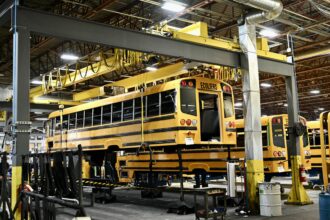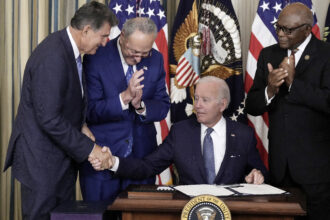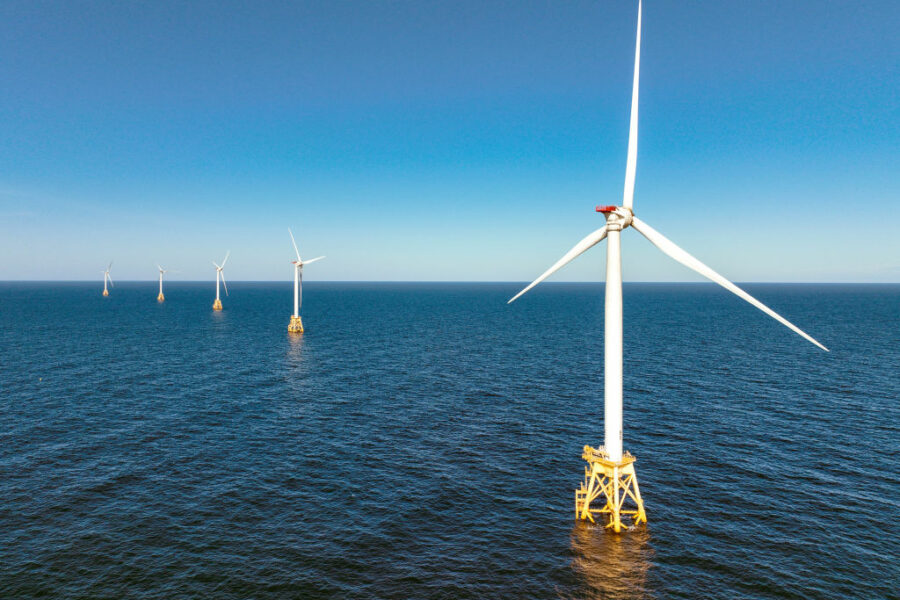One goal of the Inflation Reduction Act is to make sure that jobs created by the transition to clean energy have high standards for wages and benefits. The Biden administration is now providing some specifics about how this will work.
The Treasury Department and the IRS released a proposed rule last week that spells out what companies need to do to qualify for tax credits tied to labor standards under the 2022 law.
I spoke with people from unions and clean energy industry groups to get an idea of whether the proposal is substantial enough for workers, while being flexible enough to avoid being cumbersome for companies. The initial reviews range from positive to noncommittal.
“This is a big step forward,” said Kevin Reilly, assistant director for policy at the Laborers’ International Union of North America, whose members include people who work on large projects across the energy economy.
But let’s back up a few steps for perspective.
The Inflation Reduction Act has a variety of tax credits for energy projects. The incentives are much higher for projects that meet standards for wages, benefits and apprenticeships. For example, the investment tax credit—which is applicable to many kinds of clean energy projects—is worth 30 percent of the cost of a project that meets labor standards. The credit drops to 6 percent if the project doesn’t meet the standards.
That’s a huge gap. A $1 billion solar project stands to get a base credit of $300 million if it meets labor standards, or $60 million if it doesn’t.
To qualify for the 30 percent credit, a project must pay workers the prevailing wage, which is a calculation of wages and benefits that is often roughly equivalent to a local area’s union-scale wages.
A project also needs to contribute to the training of clean energy workers with a requirement that a specified share of the labor hours on a project be performed by people working through a certified apprenticeship program. The share is 12.5 percent of total hours on projects in 2023, and then 15 percent of total hours in 2024 and after.
The proposed rule goes into detail about how employers will show compliance, among many other issues.
One provision allows for a “good faith” exception to the apprenticeship requirement. If a company tries to hire enough apprentices, but finds that there are not enough people available, then the business can claim this exception and still receive the full tax credit.
But there are conditions. First, a company needs to be able to document that it made an effort to get apprentices with adequate lead time to give local training programs an opportunity to participate.
Next, a company needs to show that it followed up to see if apprentices may be available later in a project’s timeline.
One of the big priorities for unions is the inclusion of strong language to encourage companies to comply with pay standards and correct any failure to meet the standards.
Reilly said he is pleased to see that the proposal says a company that reports errors within 30 days of discovering them can get a waiver of penalties. He thinks this is a powerful inducement for companies to look for errors and fix them. The alternative would be to pay a penalty of $5,000 for each worker who was underpaid.
Regardless of whether a company pays penalties, the workers would receive back pay plus interest.
Keep Environmental Journalism Alive
ICN provides award-winning climate coverage free of charge and advertising. We rely on donations from readers like you to keep going.
Donate NowAnother provision says that the wage rules apply to everyone who works on a project, even subcontractors. This is important because the use of subcontractors otherwise would be a loophole that companies could exploit, said Jason Walsh, executive director of the BlueGreen Alliance, a coalition of labor unions and environmental groups.
“Everybody who qualifies (as a worker) on the project needs to be held to the standards,” he said.
Several clean energy business groups issued statements praising or acknowledging the proposals, but they were light on specifics.
“We believe this rulemaking supplies much needed certainty on how developers may satisfy these requirements and access full-value tax credits,” said Gregory Wetstone, president and CEO of the American Council on Renewable Energy, a trade group.
Ben Norris, senior director of regulatory affairs for the Solar Energy Industries Association, said companies “need workable regulations that take into account the availability of current apprenticeship programs,” but he did not comment on whether his organization supports the way the rule deals with this issue.
Clean energy business groups like the idea of tax breaks, of course. And, if they don’t like requirements that increase labor costs, they aren’t saying so.
The Treasury Department and the IRS will take public comments on the proposal through the end of October and then will hold a public hearing on Nov. 21. Then, officials from the agencies will have an opportunity to revise the proposal before finalizing it.
The Biden administration has taken several notable actions through the federal rules process to try to improve pay levels for workers. Last month, the Department of Labor issued a final rule to revise the Davis-Bacon Act, the 1931 law that requires the payment of prevailing wages for public works projects. It was the first major revision of the law since the Reagan administration.

I’m mentioning the Davis-Bacon Act because the IRA specifies that projects receiving tax credits—even privately owned and financed projects—need to follow the wage rules from 1931 law.
This is a big change. Before the IRA, there were no wage rules for federal clean energy tax credits.
Many Republican lawmakers and right-leaning think tanks would like to ease or eliminate the requirements of Davis-Bacon. The IRA labor rule shows how the Biden administration is going in the opposite direction by expanding the use of wage standards for projects receiving federal aid—to the delight of union leaders.
“President Biden is walking his talk on being the most pro-union president of our lifetime,” Walsh said. “He is tightening up and strengthening the laws that the unionized building trades rely on to ensure that their members have not just a job here and a job there, but real middle-class careers.”
Other stories about the energy transition to take note of this week:
Energy Department Offers $15.5 Billion to Retool Auto Plants for EVs: The Biden administration last week announced $15.5 billion through the Department of Energy to help U.S. automakers modify existing plants so they can make EVs. The funding comes from several sources, including the Inflation Reduction Act, as Maria Gallucci reports for Canary Media. “While we transition to EVs, we want to ensure that workers can transition in place, that there is no worker, no community left behind,” Energy Secretary Jennifer Granholm told reporters.
LG Energy, Hyundai to Invest an Additional $2 Billion in Georgia Battery Cell Plant: LG Energy Solution and Hyundai are increasing their investment in a battery cell plant in Georgia, as Sara Samora reports for Utility Dive. The new spending of $2 billion is in addition to the $4.3 billion that the companies had previously announced. The battery plant will be next to a Hyundai manufacturing campus scheduled to open in 2025 with capacity to produce 300,000 electric vehicles per year. Hyundai’s initial plans for Georgia were an economic development coup, as is this latest expansion of those plans.
Wind Energy Giant Orsted Says Delays in U.S. May Cost $2 Billion: Orsted, the Danish renewable energy giant, is warning that supply chain problems and high interest rates are leading to delays and cost increases for U.S. offshore wind farms. The company warned that it may write off as much as $2.12 billion because of the issues, as Stanley Reed reports for The New York Times. The company’s comments are about three offshore wind projects planned to serve customers in Connecticut, New Jersey and New York. Mads Nipper, Orsted’s CEO, told Bloomberg that it’s a “real option” to abandon the projects unless the financial picture improves, which could include getting additional support from the Biden administration or state governments. Orsted’s comments are the latest in a series of indications that the economics of offshore wind have shifted in a way that will make projects more challenging, at least in the near term.
North Atlantic States Consider a Transmission Backbone to Support Offshore Wind: States from Maine to New Jersey are looking at a variety of options to build the high-voltage lines that will be needed to connect offshore wind farms with onshore customers, as Heather Richards and Miranda Willson report for E&E News. The states and companies involved could create substantial cost savings by working together to build the underwater lines in the most efficient ways possible, but it’s not clear that the parties will be able to agree on how to proceed.
Finding a Technician to Fix Your EV May Take a While: A global shortage of technicians and repair shops qualified to fix EVs could increase repair costs for drivers, as Nick Carey, Paul Lienert and Giulio Piovaccari report for Reuters. Auto repair training organizations say that independent repair shops will be essential for making EVs affordable, but not enough shops are willing to go through the sometimes costly process of training workers.
Inside Clean Energy is ICN’s weekly bulletin of news and analysis about the energy transition. Send news tips and questions to [email protected].













